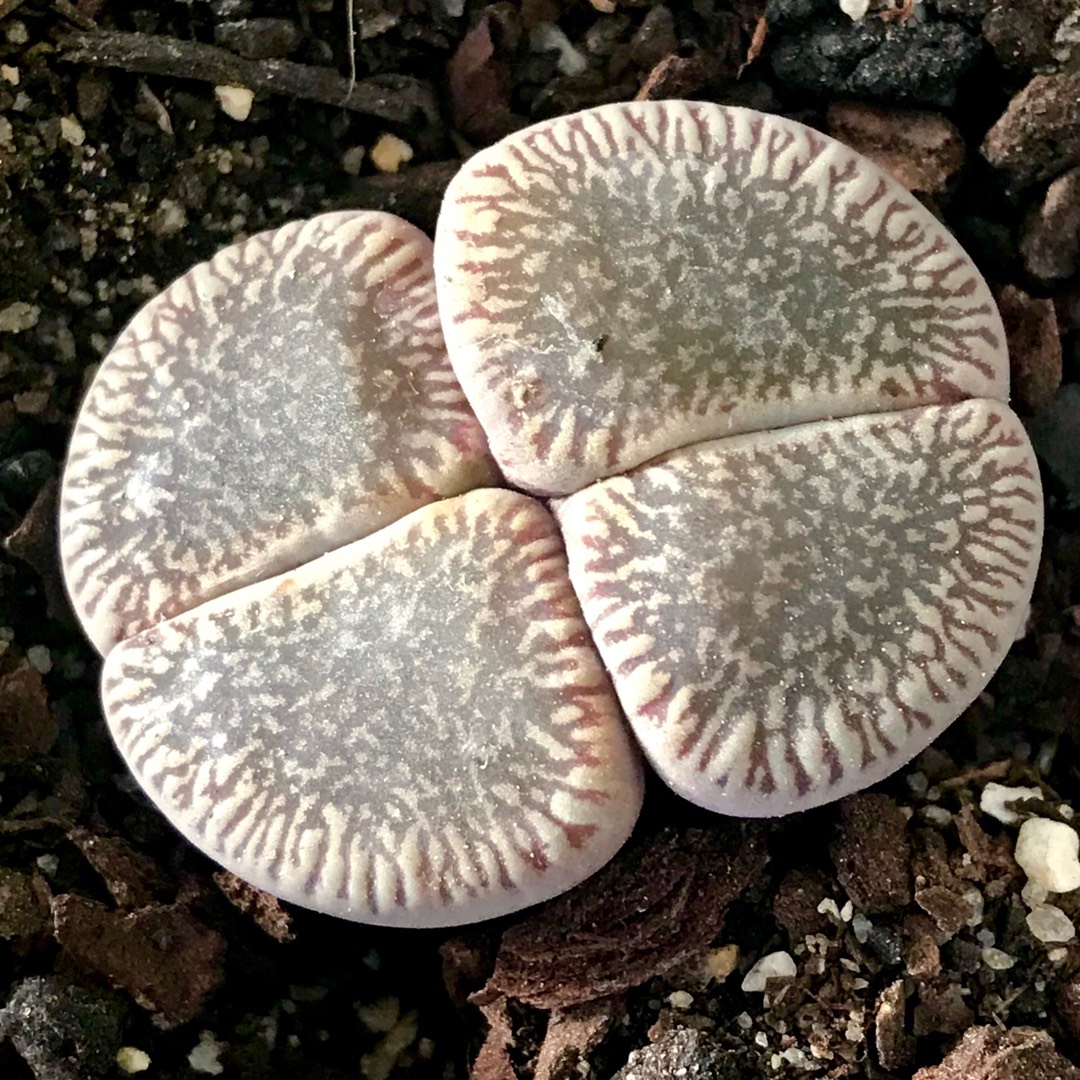
Lithops Aucampiae var. Fluminalis
Living Stones 'Aucampiae Fluminalis'
Original:Description: Lithops aucampiae subsp. euniceae var. fluminalis is an exquisite 'grey form” distiguishable from the var. euniceae for the finer and more numerous finger-like projections and marking on the margin and for the dark-grey overall colour. The plant in winter often take a paler greenish-grey colouration. Habit: It slowly clumps forming cluster up to 200 mm in diameter, with up to 10 heads.Bodies (paired leaves): Medium to large, facial diameters 25-40 mm in length and 20-30 mm wide. Profile truncate; top surface flat to slightly convex; fissure shallow, 3-6 mm; lobes conjunct. The plants prevalent colour is dark grey/brown with variable markings on the top surface. Windows and channels, usually broad, occasionally reduced to narrow grooves, obscurely translucent dark grey or dull brow. The finger-like lines organized into rays around the margins usually are distinctly dark grey or brown, and form an elegant lace, sometimes overflowing even on the sides. Dusky dots dull greenish grey. Shoulders milky bluish, pinkish or greenish grey.Flowers: Yellow, medium to large, up to 45 mm Ø, mostly 25-35 mm Ø.Fruit: Mostly 6 chambered. New:A popular and sought after succulent. Lithops have paired leaves with smooth flat or rounded tops that are ridged or wrinkled, sometimes with transparent windows, and sometimes colorful markings. The flowers are white or yellow and emerge in autumn or winter. Lithops are relatively easy to grow if given sufficient sun and a suitable well-drained soil.
-
Full sun to partial shade
-
Very little water
-
Not Frost hardy
-
Light and free draining
Common name
Living Stones 'Aucampiae Fluminalis'
Latin name
Lithops Aucampiae var. Fluminalis
type
Succulent
family
Aizoaceae
ph
5.0 - 6.5 Acid - Neutral
Plant & bloom calendar
-
Best time to plant
full grown dimensions
 0.02 M
0.01 M
0.02 M
0.01 M
Lithops Aucampiae var. Fluminalis
Original:Description: Lithops aucampiae subsp. euniceae var. fluminalis is an exquisite 'grey form” distiguishable from the var. euniceae for the finer and more numerous finger-like projections and marking on the margin and for the dark-grey overall colour. The plant in winter often take a paler greenish-grey colouration. Habit: It slowly clumps forming cluster up to 200 mm in diameter, with up to 10 heads.Bodies (paired leaves): Medium to large, facial diameters 25-40 mm in length and 20-30 mm wide. Profile truncate; top surface flat to slightly convex; fissure shallow, 3-6 mm; lobes conjunct. The plants prevalent colour is dark grey/brown with variable markings on the top surface. Windows and channels, usually broad, occasionally reduced to narrow grooves, obscurely translucent dark grey or dull brow. The finger-like lines organized into rays around the margins usually are distinctly dark grey or brown, and form an elegant lace, sometimes overflowing even on the sides. Dusky dots dull greenish grey. Shoulders milky bluish, pinkish or greenish grey.Flowers: Yellow, medium to large, up to 45 mm Ø, mostly 25-35 mm Ø.Fruit: Mostly 6 chambered. New:A popular and sought after succulent. Lithops have paired leaves with smooth flat or rounded tops that are ridged or wrinkled, sometimes with transparent windows, and sometimes colorful markings. The flowers are white or yellow and emerge in autumn or winter. Lithops are relatively easy to grow if given sufficient sun and a suitable well-drained soil.
Planting
From Early Spring TO Early Spring
Lithops thrive best in a coarse, well-drained substrate. Any soil that retains too much water will cause the plants to burst their skins as they over-expand. Plants grown in strong light will develop hard strongly coloured skins which are resistant to damage and rot, although persistent overwatering will still be fatal. Excessive heat will kill potted plants as they cannot cool themselves by transpiration and rely on staying buried in cool soil below the surface.
Propagation
From Early Spring TO Early Spring
Propagation of Lithops is by seed or cuttings. Cuttings can only be used to produce new plants after a plant has naturally divided to form multiple heads, so most propagation is by seed. Lithops can readily be pollinated by hand if two separate clones of a species flower at the same time, and seed will be ripe about 9 months later. Seed is easy to germinate, but the seedlings are small and vulnerable for the first year or two, and will not flower until at least two or three years old.








